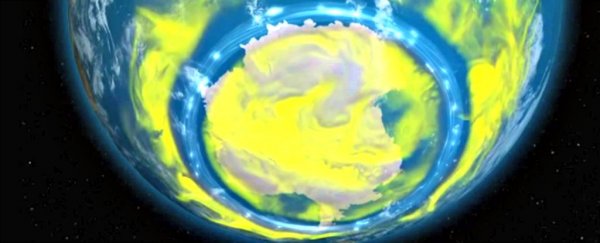The historic 1987 treaty to fight the hole in the ozone layer wasn't just an international success story – it was a stunning environmental victory that's still saving the planet in unexpected ways some 30 years later.
The Montreal Protocol successfully outlawed harmful chemicals that deplete ozone in the atmosphere, but new research shows the ban had an amazing, unforeseen side effect: drastically slashing greenhouse gas emissions in the US.
A new analysis led by the Cooperative Institute for Research in Environmental Sciences (CIRES) is the first study using atmospheric observations to quantify the impact of the Montreal Protocol on US greenhouse gas emissions.
The results show that banning the use of ozone-depleting substances such as chlorofluorocarbons (CFCs) and hydrochlorofluorocarbons (HCFCs) had ramifications far beyond the intended aim of restoring ozone levels in the atmosphere and plugging the hole in the ozone layer.
Between 2008 and 2014, the prohibition on these environmentally harmful chemicals actually eliminated the equivalent of 170 million tonnes of carbon dioxide (CO2) emissions each year.
 NOAA/CIRES
NOAA/CIRES
"We were surprised by the size of the decline, especially compared with other greenhouse gases," says lead researcher Lei Hu.
It's a staggering result – equivalent to about half the reductions achieved in the US for CO2 and other greenhouse gases in the same period – and one that was never anticipated by the Montreal Protocol's framers back in the 1980s, before the true extent of today's global warming predicament was known throughout the science world.
Previous research had already demonstrated this beneficial side effect of the ozone-depleting chemicals ban in an international context, but the new study is the first to look at how the thermal changes play out in North America's atmosphere.
The researchers predict that by reducing the volume of CFCs and HCFCs in the air – potent gases that can trap heat up to 10,000 times greater than CO2, in addition to harming ozone – the Montreal Protocol will produce even greater atmospheric benefits in the future.
Specifically, by 2025, the team estimates the Montreal Protocol will effectively reduce US greenhouse gas emissions by the equivalent of 500 million tonnes of CO2 annually compared with 2005 levels.
Not bad at all for a treaty moonlighting on its day job, given this equates to approximately 25–30 percent of the US target originally committed to at the UN's Paris climate deal, COP 21.
"Most of these reductions will be in addition to what is achieved by COP21 because ozone-depleting substances are not included in COP21 targets," Hu explains.
Of course, the Montreal Protocol hasn't just solved everything in relation to the ozone layer. Another unintended side effect of the treaty – and this time, not a positive one – was the introduction of hydrofluorocarbons (HFCs).
This alternative chemical was developed to take the place of CFCs and HCFCs in things like refrigerators and air conditioners where it's used as a coolant, but while HFCs don't hurt ozone, they're still devastatingly effective at trapping heat – so not something we want just hanging around in our atmosphere.
Fortunately, an amendment to the Montreal Protocol last year will phase out these dangerous substitutes too – a move that then US Secretary of State John Kerry applauded as "likely the single most important step we could take at this moment to limit the warming of our planet and limit the warming for generations to come".
We still don't know how for sure how impactful that amendment will turn out to be – but if it's anything like its protocol parent, we're hoping for great things.
We may still have a long way to go in fixing Earth's ozone problems for good, but it's undeniable that the Montreal Protocol has been a great thing for the planet (HFCs notwithstanding).
It's helped ozone, it's hindered climate change.
And it serves as a great example of how, 30 years ago, the world united as one to avert a towering environmental catastrophe – an invaluable, inspiring piece of history we can never forget.
The findings are reported in Geophysical Research Letters.
